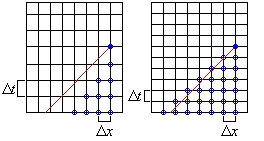The Courant-Friedrichs-Lewy Condition
The CFL condition requires that the numerical domain of dependence of a finite difference scheme include the domain of dependence of the associated PDE. Therefore, satisfaction of the CFL condition is a necessary, but not sufficient, condition to guarantee the convergence of the finite-difference (numerical) approximation to the solution of the PDE.
Define the domain of influence of a point $$(x_0,t_0)$$ as the region of the $$(x,t)$$ plane where the solution of the partial differential equation is influenced by the solution at $$(x_0,t_0)$$.
Define the domain of dependence of $$(x_0,t_0)$$ as the set of points containing $$(x_0,t_0)$$ within their domains of influence.
The numerical domain of dependence of a gridpoint $$(x_i,t_k)$$ consists of the set of all discrete points at which the value of the numerical solution influences the solution at $$(x_i,t_k)$$.
The true domain of dependence is the dashed line in (red) the two panels on the right. The point $$(x_0, t_0)$$ is shown in blue. Note that the size of the time steps, $$\Delta t$$, is smaller in the second panel. The numerical domain of dependence is shown by the blue circles.

In the first panel, the true domain of dependence is larger than the numerical domain of dependence. In the second panel, however, the numerical domain of dependence contains all of the true (analytical) domain of dependence. Therefore, a finite difference approximation using the grid in the first panel will be guaranteed not to converge since it fails the CFL condition. This shows that the size of the time steps (when the spatial grid size is fixed) directly affects the convergence of the solution.
Glossing over the mathematical details, the CFL condition is given by:
